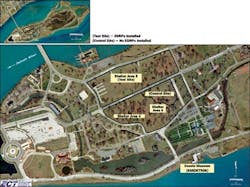Sewer & Collection Systems: Augmenting Green Infrastructure
Parjana Distribution LLC (PD) offers a means of increasing the infiltration rate without jeopardizing groundwater quality. The technology allows public works officials to improve the performance of both green and gray drainage infrastructure. To document the performance of the patented process, PD obtained funding from the Michigan Economic Development Corporation and H2Opportunities (H2Opps—a water technology accelerator) to demonstrate to State and local officials the reduction in storm water runoff on Belle Isle, a highly utilized urban park. Through this project, PD and its partners realized over an 80% reduction in the volume of storm water runoff after the acclimation period was substantially complete in the test area.
Storm water on the approximately 982-acre Belle Isle Park, in Detroit, Mich., is collected in a network of very old, undocumented separate storm sewers leading to a combined sewer where it is then transported to the Detroit Water and Sewerage Department (DWSD) wastewater treatment plant. The result is excessive storm water being delivered to the wastewater treatment plant for treatment.
Excess storm water also is the cause of combined sewer overflows that pose a billion plus dollar liability to the city. DWSD continues to seek ways to reduce peak discharge flows by reducing the storm water that enters the system. This demonstration project was initiated to estimate the amount of storm water that could be eliminated from the Belle Isle storm sewer collection system.
PD initially proposed this demonstration project to H2Opps for design and construction of a storm water mitigation technology known as Energy-Passive Groundwater Recharge Product (EGRP). The fundamental premise of this project was that the installation of EGRP would lessen the amount of water delivered to the storm sewer system. Environmental Consulting & Technology Inc. (ECT) performed third-party monitoring, data collection and analysis of this system from 2013 to 2015.
The EGRP’s layout was designed and installed by PD personnel. The EGRP typically require a minimum period of acclimation of approximately three months after installation to become fully effective, and performance continues to improve for up to 15 months. The acclimation period varies by site and can be influenced by environmental factors such as soil type, climate, depth to groundwater, etc. For the Belle Isle site, measurable results point to an acclimation period of approximately nine months.
Significant Reduction in Runoff Volume
The storm water volume data from the test site was compared using pre-installation volume vs. post installation (once EGRP experienced substantial acclimation). Flowmeters were installed in manhole structures and recorded storm sewer flow (gallons per day) documenting approximately 80% reduction in total flow.
Putting this reduction in context:
- The city of Detroit experiences approximately 31 in. of rainfall per year;
- Prior to EGRP installation, the expected storm water runoff from this 23-acre portion of Belle Isle was more than 55 million gal per year; and
- Post-EGRP Installation (substantial acclimation complete), this Belle Isle storm sewer will carry less than 6 million gal per year.
No Impact on the Water Table
The soils at the installation site were very tight—predominantly of interbedded sands and clays covered by “urban fill.” The water table (potentiometric surface) was monitored at both the control site (P-4) and test site (P-2) using piezometers and results compared. The rate of change for flow and precipitation, per time step, was compared for both flow and precipitation at each site to monitor any effect on groundwater flow.
Control site results shows that, without EGRP, the change in groundwater flow mirrors the change in precipitation (i.e., the slopes of the two lines are similar). Test site results show that after EGRP installation, the groundwater flow increases more slowly (i.e., the slope is flatter) than the precipitation. This proved that the area of EGRP installation washed out the continuous I/I and inflow from the nearby Detroit River and pond on Belle Isle, in addition to reducing the rainfall runoff into the existing storm infrastructure.
No Impact on Groundwater Quality
According to the collected data, there does not appear to be any discernible adverse effect to shallow groundwater quality due to the installation of EGRP’s on the test area. Groundwater samples were collected from the test area and the control area using a peristaltic pump. The results are summarized in the table and compared with Michigan Department of Environmental Quality Non-residential Drinking Water cleanup criteria, and with average results from the Lake St. Clair Regional Monitoring Project (dry and wet weather). No difference in groundwater quality was observed between the test and control locations.
Moving Forward
Since the completion of this study, the technology has been applied to a number of green infrastructure projects with the specific aim of reducing the cost of construction and storm water flow from a site. By increasing the infiltration rate at confined site locations, storm water capture volumes have been reduced because the volume captured can be drained more rapidly and therefore available for the next event. The technology is being coupled with other innovations in a systems approach—including porous aggregate and pretreatment catch basins—to effectively reduce storm water management costs while complying with mandatory post construction storm water management requirements. This systems approach also provides for storm water to be held for the peak storm events and then allows the storm water to infiltrate over time, thereby minimizing peak storm discharges, reducing downstream flooding, capturing storm water pollutants, and recharging groundwater—all goals of the storm water regulations.
Download: Here
